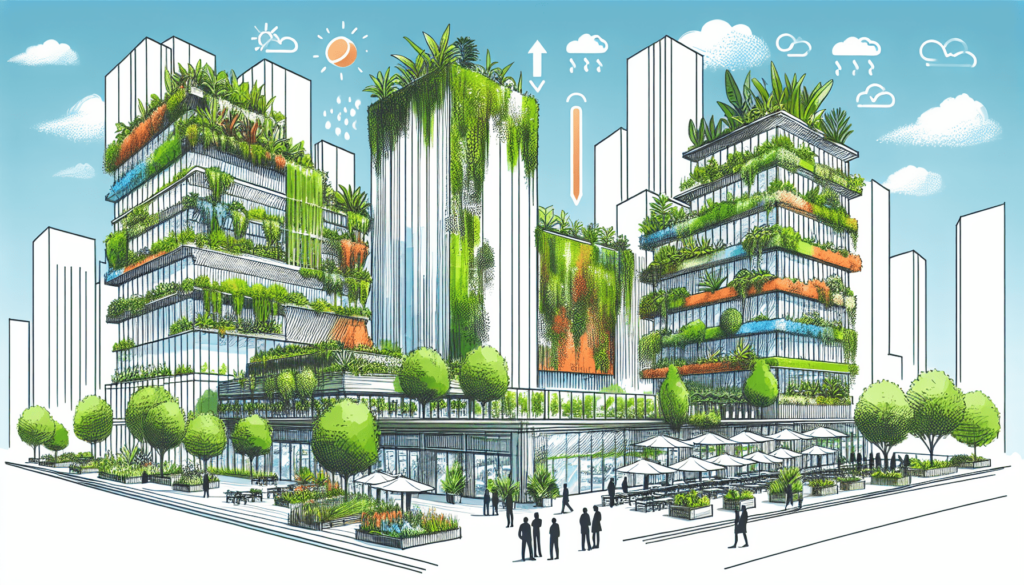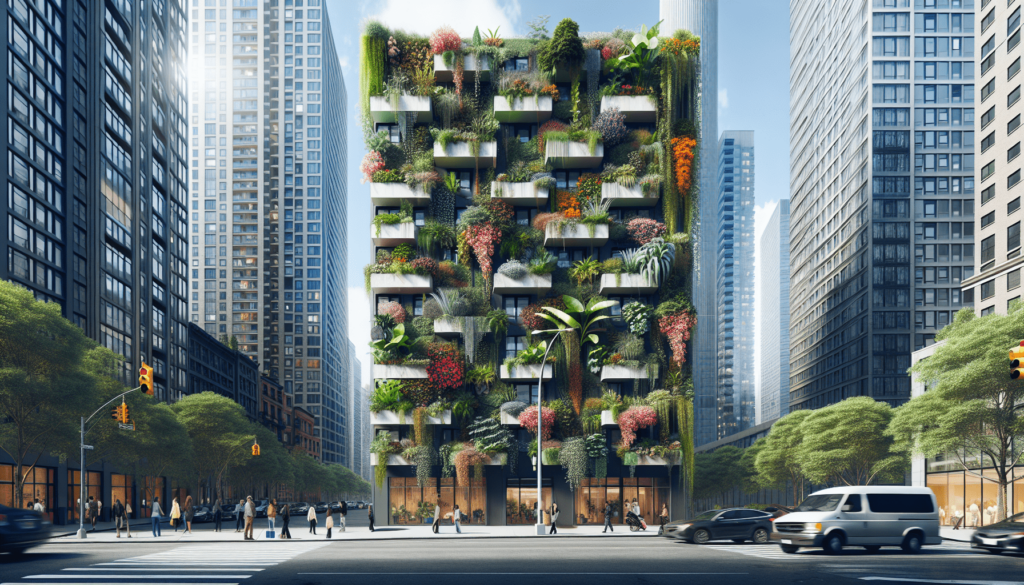Disclosure: As participants in the Amazon Associates Program, we earn from qualifying purchases. This means when you click on an Amazon link on this page and make a purchase, we receive a commission. This doesn’t affect the price you pay but it does help us to keep producing the content you love to see. We always aim for honesty and transparency in everything we do, and your support means the world to us. Thank you for helping us grow and for being part of our community.
Imagine stepping into a digital garden, where every click blossoms into a wealth of knowledge and inspiration for vertical gardening enthusiasts. That’s the essence of our website, a specialized platform dedicated to the green, upwardly mobile world of vertical garden kits. Here, we cultivate a diverse ecosystem of blog articles designed to educate, inspire, and empower gardeners of all levels to transform their living spaces, no matter how limited, into lush vertical oases. From the basics of setting up your first vertical garden kit to exploring the latest trends in vertical horticulture, our articles cover the entire spectrum. Whether you’re looking to grow herbs on your kitchen wall, create a living mural of succulents, or harvest fresh vegetables from your balcony garden, our website is your guide through the vertical gardening journey. Join us in creating greener, more sustainable environments one vertical garden at a time.

This image is property of images.pexels.com.
Benefits of Vertical Gardens
Maximizing Space
Living in urban areas often means dealing with limited space, and that’s where vertical gardens come to the rescue. By utilizing vertical wall space, you can transform even the smallest of areas into a flourishing garden. Whether you have a tiny balcony, a compact office space, or a narrow hallway, a vertical garden allows you to maximize your available space and bring nature into areas where traditional gardens may not be feasible.
Improving Air Quality
One of the most significant benefits of vertical gardens is their ability to improve air quality. Plants naturally absorb carbon dioxide and release oxygen, which helps to purify the air we breathe. By incorporating a vertical garden into your living or working space, you can create a healthier environment and reduce the presence of harmful pollutants. Not only does this enhance the overall air quality, but it also has positive effects on your physical and mental well-being.
Reducing Energy Consumption
Vertical gardens offer a natural solution for reducing energy consumption. By acting as a barrier against direct sunlight, a well-designed vertical garden helps to insulate buildings, keeping them cool during the summer and reducing the need for excessive air conditioning. This can translate into savings on energy bills and a more sustainable approach to cooling your living or working spaces. Additionally, the shade provided by the plants can mitigate the urban heat island effect, making cities more comfortable and reducing overall energy demand.
Enhancing Aesthetics
In addition to their functional benefits, vertical gardens also enhance the aesthetics of any space. With a wide variety of plants to choose from, you can create a visually stunning display that adds vibrancy and vitality to your surroundings. Whether you prefer a vibrant mosaic of colors or a serene green backdrop, a vertical garden allows you to express your personal style and create a unique atmosphere. Not only will you enjoy the beauty of your vertical garden, but it will also serve as a conversation starter and a source of inspiration for others.
Choosing the Right Vertical Garden Kit
Consider the Space Available
Before diving into the world of vertical gardening, it’s essential to consider the space you have available. Take measurements of the wall or structure where you plan to install the vertical garden and determine how much space you can allocate for the kit. This will help you choose the right size and configuration that fits your specific needs and ensures a seamless integration into your space.
Assess the Lighting Conditions
Lighting is a crucial factor in the success of any vertical garden. Different plants have varying light requirements, so it’s essential to assess the available lighting conditions in your chosen location. Is the area directly exposed to sunlight, partially shaded, or predominantly shaded? Understanding the lighting conditions will guide you in selecting plants that thrive in those specific conditions and ensure their healthy growth and development.
Select the Right Plants
Once you have assessed the lighting conditions, it’s time to select the plants for your vertical garden. Consider the size, growth habit, and care requirements of each plant. Opt for plants that are suitable for vertical growth and have a compact or trailing habit to maximize the use of space. Choose a mix of plants with different textures, colors, and heights to create a visually appealing and diverse vertical garden.
Evaluate the Maintenance Requirements
Every vertical garden requires regular maintenance to thrive, but the level of maintenance needed can vary depending on the plant selection and your lifestyle. Consider your availability and gardening experience when choosing plants for your vertical garden. If you have limited time or are new to gardening, opt for low-maintenance plants that require minimal care and are more forgiving of occasional neglect. On the other hand, if you enjoy spending time in your garden and have the knowledge and skills to care for more demanding plants, you can choose a wider range of species to create a lush and vibrant vertical garden.

This image is property of images.pexels.com.
Setting Up Your Vertical Garden Kit
Preparing the Wall or Structure
Before installing your vertical garden kit, it’s important to properly prepare the wall or structure where it will be mounted. Ensure that the surface is clean, free of any debris or loose paint, and in good condition. If necessary, repair any cracks or imperfections before proceeding with the installation. This will provide a stable and secure foundation for your vertical garden.
Installing the Support System
The support system is a crucial component of your vertical garden kit, as it will hold the planters securely in place. Follow the manufacturer’s instructions to install the support system correctly. Depending on the design of your kit, this may involve attaching brackets or hooks to the wall, or using a freestanding structure. Ensure that the support system is firmly attached and can withstand the weight of the planters and plants.
Arranging the Planters and Plants
Once the support system is in place, it’s time to arrange the planters and plants in your vertical garden. Start by positioning the planters on the support system, taking care to evenly distribute the weight. Consider the visual aesthetic and spacing between the planters, ensuring that each plant has enough room to grow and thrive. Once the planters are in place, carefully plant each selected plant, following proper planting techniques and guidelines for each species.
Ensuring Proper Drainage
Proper drainage is essential for the health and longevity of your vertical garden. Ensure that each planter has adequate drainage holes to prevent waterlogging and the accumulation of excess moisture. If your support system allows for it, consider placing a tray or catchment system at the bottom to collect excess water and prevent damage to your walls or floors. Regularly monitor the drainage system and adjust as needed to maintain optimal moisture levels for your plants.
Top Plants for Vertical Gardens
Herbs and Edible Greens
Herbs and edible greens are excellent choices for vertical gardens, as they are not only visually appealing but also serve a practical purpose in the kitchen. Basil, parsley, mint, and thyme are just a few examples of herbs that thrive in vertical gardens. Lettuce, spinach, and kale are also great options for adding a fresh and nutritious touch to your meals. By growing your own herbs and greens vertically, you can enjoy a continuous supply of fresh ingredients right at your fingertips.
Flowering Plants
Flowering plants add a touch of beauty and elegance to any vertical garden. Consider plants like petunias, geraniums, and begonias for vibrant bursts of color. Climbing roses, clematis, and morning glories can also be trained to grow vertically and create stunning floral displays. By incorporating flowering plants into your vertical garden, you can create a visually stunning focal point and attract beneficial pollinators to your space.
Ferns and Mosses
Ferns and mosses are excellent options for creating a lush and verdant vertical garden. With their delicate foliage and ability to thrive in shady areas, they add a touch of tranquility and serenity to any space. Boston ferns, maidenhair ferns, and mosses like Hypnum and Sphagnum are great choices for a vertical garden that exudes a calming and soothing atmosphere.
Succulents and Cacti
For those looking for low-maintenance plants that are drought-tolerant and require minimal watering, succulents and cacti are ideal choices for vertical gardens. Their unique shapes and textures create an intriguing and sculptural effect, adding visual interest to your space. Echeverias, sedums, and jade plants are popular varieties that thrive in vertical gardens and bring a touch of desert beauty to your living or working area.

This image is property of images.pexels.com.
Maintaining Your Vertical Garden
Watering and Fertilizing
Watering and fertilizing are crucial aspects of maintaining a healthy and thriving vertical garden. As vertical gardens tend to dry out more quickly than traditional gardens, it’s important to monitor the moisture levels and adjust your watering routine accordingly. Regularly check the soil moisture by inserting your finger into the soil to ensure it is adequately hydrated. Consider using a drip irrigation system or self-watering planters to provide a consistent and efficient watering method. Additionally, fertilize your plants regularly with a suitable fertilizer to ensure they receive the nutrients they need for optimal growth.
Pruning and Trimming
Proper pruning and trimming are essential for maintaining the shape and health of your vertical garden. As plants grow, they may start to become unruly or overshadow others, affecting the overall aesthetic and health of the garden. Regularly inspect your plants for any dead or damaged foliage and remove them promptly. Prune or trim any overgrown branches or stems to maintain the desired shape and prevent overcrowding. By keeping your vertical garden well-groomed, you can ensure healthy growth and prolong the lifespan of your plants.
Controlling Pests and Diseases
Vertical gardens, like any other garden, are susceptible to pests and diseases. Regularly inspect your plants for signs of pests, such as aphids or spider mites, and take appropriate measures to control them. Use organic pest control methods whenever possible to avoid harming beneficial insects and pollinators. Additionally, be vigilant for any signs of diseases, such as fungal infections or rot, and address them promptly by removing affected plants or treating them with suitable remedies.
Monitoring Light and Temperature
As mentioned earlier, lighting conditions play a crucial role in the success of your vertical garden. Monitor the natural light levels in your chosen location and ensure that your plants are receiving the appropriate amount of light. If necessary, supplement with artificial lighting to provide consistent and adequate illumination. Additionally, be mindful of temperature fluctuations, especially if your vertical garden is located outdoors or in areas with extreme climates. Protect your plants from frost, excessive heat, or strong winds to prevent stress or damage.
Creative Ideas for Vertical Gardens
The Living Wall Art
Transform your blank walls into living works of art with a vertical garden mural. Choose a variety of plants that offer different colors, textures, and growth habits to create a visually stunning and dynamic display. Arrange the plants in patterns or shapes that reflect your artistic vision, whether it’s a flowing abstract design or a precise geometric pattern. Not only will this add a unique and eye-catching element to your space, but it will also bring nature indoors and foster a sense of serenity and creativity.
Vertical Herb Garden in the Kitchen
Bring fresh herbs into your kitchen with a vertical herb garden. Install a vertical garden kit on a kitchen wall or use hanging planters to create a space-saving herb garden. Choose herbs that are commonly used in your cooking and enjoy a continuous supply of fresh ingredients just steps away from your stove. The convenience of having herbs readily available will not only enhance the flavors of your dishes but also add a touch of greenery to your culinary space.
Balcony Veggie Patch
If you have a small balcony, turn it into a productive vegetable garden with vertical planters. Grow a variety of vegetables like cherry tomatoes, peppers, and cucumbers vertically to maximize space and yield. The vertical structure will not only allow you to grow a greater variety of vegetables but also provide additional support for climbing plants like beans or peas. Harvesting your own fresh vegetables from your balcony veggie patch will bring a sense of satisfaction and contribute to a more sustainable lifestyle.
Vertical Garden Room Divider
Create privacy and define separate areas in your living or working space with a vertical garden room divider. Install a vertical garden kit that doubles as a partition or use stacked planters to create a living wall that separates different zones. Choose plants with dense foliage that provide visual screening and sound absorption, such as bamboo, ferns, or tall grasses. This creative solution not only adds a touch of greenery but also adds a sense of privacy and tranquility to your space.

Vertical Gardens for Small Spaces
Vertical Gardens in Apartments
Living in an apartment doesn’t mean you can’t enjoy the benefits of a vertical garden. Install a vertical garden kit on your balcony, terrace, or even indoors near a sunny window. Choose compact and trailing plants that are suitable for small spaces and adapt well to indoor conditions. Vertical gardens in apartments not only bring nature closer to urban dwellers but also provide a sense of tranquility and connection with the natural world in a limited space.
Vertical Gardens in Office Spaces
Office spaces often lack greenery, but vertical gardens can transform these sterile environments into vibrant and productive spaces. Install a vertical garden in the office lobby, relaxation areas, or even individual workstations to create a biophilic workspace. Choose low-maintenance plants that can thrive in office lighting conditions and contribute to better air quality. A vertical garden in the office not only enhances the aesthetics but also promotes a healthier and more productive working environment.
Vertical Gardens in Rooftop Gardens
Rooftop gardens offer a unique opportunity to create lush and expansive vertical gardens. Utilize the vertical wall space surrounding your rooftop garden by installing vertical garden kits. Incorporate a mix of plants, such as climbers, flowering vines, and cascading plants, to create a multi-layered and visually stunning vertical garden. Not only will this add beauty and greenery to your rooftop space, but it will also enhance insulation, reduce energy consumption, and mitigate the urban heat island effect.
Vertical Gardens in Balconies
Balconies provide a perfect setting for vertical gardens, as they offer limited floor space but ample vertical surface area. Install a vertical garden kit on your balcony railing or adjacent wall to create a lush and inviting oasis. Choose plants that can tolerate wind, sunlight, and temperature fluctuations, as balconies can be exposed to different weather conditions. Vertical gardens in balconies not only beautify the space but also provide privacy, reduce noise, and create a peaceful retreat in the midst of the city.
Vertical Gardens for Sustainable Living
Reducing Food Miles
Vertical gardens contribute to sustainable living by reducing food miles. By growing your own herbs, vegetables, and fruits vertically, you can reduce your dependence on store-bought produce that often travels long distances to reach your plate. Harvesting fresh ingredients from your vertical garden not only promotes sustainable farming practices but also ensures a direct and shorter supply chain, reducing your carbon footprint and supporting local food systems.
Growing Native Plants and Biodiversity
Vertical gardens provide an opportunity to grow native plants and promote biodiversity in urban areas. By selecting native plant species for your vertical garden, you can create habitats for local wildlife, attract beneficial insects, and contribute to the overall ecological balance. Native plants are well-adapted to local climate conditions and require less water and maintenance than non-native species. By incorporating native plants into your vertical garden, you can play a part in preserving local ecosystems and supporting biodiversity.
Rainwater Harvesting
Vertical gardens can help in conserving water through rainwater harvesting. Set up a rainwater harvesting system and direct the collected rainwater to irrigate your vertical garden. By using rainwater instead of potable water, you can reduce water consumption and preserve precious water resources. Additionally, rainwater is often free of the chemicals and additives found in tap water, providing a more natural and beneficial water source for your plants.
Composting and Recycling
Composting is an important aspect of sustainable gardening, and vertical gardens can play a role in this process. Use a portion of your vertical garden to create a composting area where you can recycle kitchen scraps, yard waste, and plant trimmings. Composting not only reduces waste that would otherwise end up in landfills but also produces nutrient-rich compost that can be used to fertilize your vertical garden. By practicing composting and recycling in your vertical garden, you can contribute to a more sustainable and environmentally friendly lifestyle.

Vertical Gardens and Mental Well-being
Stress Reduction and Relaxation
Spending time in green spaces, including vertical gardens, has been proven to reduce stress levels and promote relaxation. The calming effect of nature and the soothing sight of lush plants can help to alleviate anxiety, improve mood, and create a sense of tranquility. Whether you take a moment to sit and enjoy the peacefulness of your vertical garden or engage in gardening activities, such as planting or pruning, you can experience the therapeutic benefits that nature provides.
Indoor Air Quality and Health Benefits
Vertical gardens not only enhance the aesthetics of indoor spaces but also contribute to improved indoor air quality. Plants naturally purify the air by absorbing carbon dioxide and releasing oxygen, thereby reducing the presence of harmful pollutants. This has positive effects on respiratory health and can reduce the risk of illnesses associated with poor air quality. By incorporating a vertical garden into your indoor environment, you can create a healthier and more refreshing space for yourself and others.
Creating a Therapeutic Garden
Vertical gardens can be designed with a therapeutic focus to provide additional benefits for mental well-being. Incorporate plants that have been shown to have therapeutic effects, such as lavender, chamomile, or jasmine, to create a sensory experience that promotes relaxation and stress relief. Combine plants with different textures and scents to engage all the senses and create a serene and calming atmosphere. By consciously designing your vertical garden with therapeutic elements, you can create a personal sanctuary that promotes mental well-being.
Connection with Nature
Vertical gardens allow urban dwellers to reconnect with nature, even in the midst of a concrete jungle. By bringing plants indoors or incorporating green spaces into urban environments, vertical gardens provide a tangible and accessible connection to the natural world. The presence of plants and the vibrant colors of flowers can evoke feelings of awe, wonder, and joy, reminding us of the beauty and resilience of nature. By cultivating a vertical garden, you can nurture that connection with nature and strengthen your bond with the environment.
Conclusion
Vertical gardens have revolutionized the way we think about gardening in urban environments. By unlocking the potential of vertical spaces, these gardens allow us to bring nature into our homes, offices, and public spaces. With their numerous benefits, including space maximization, improved air quality, reduced energy consumption, and enhanced aesthetics, vertical gardens offer a sustainable and visually stunning solution for urban dwellers.
Choosing the right vertical garden kit involves considering the available space, assessing lighting conditions, selecting suitable plants, and evaluating maintenance requirements. Proper preparation and installation ensure a stable and secure vertical garden that will thrive. Top plants for vertical gardens include herbs and edible greens, flowering plants, ferns and mosses, and succulents and cacti, offering a wide variety of options for different tastes and environments.
Maintaining a vertical garden requires proper watering and fertilizing, pruning and trimming, controlling pests and diseases, and monitoring light and temperature conditions. By following these maintenance practices, your vertical garden will flourish and provide long-lasting beauty.
Creative ideas for vertical gardens include living wall art, vertical herb gardens in the kitchen, balcony veggie patches, and vertical garden room dividers. These ideas allow you to personalize and customize your vertical garden to suit your specific needs and preferences.
Vertical gardens are especially beneficial for small spaces, such as apartments, office spaces, rooftop gardens, and balconies. They provide an opportunity to introduce greenery, promote biodiversity, and foster sustainable living in these limited environments.
Beyond their physical benefits, vertical gardens also contribute to mental well-being by reducing stress, improving indoor air quality, creating therapeutic spaces, and fostering a connection with nature. By embracing vertical gardens, we can transform our urban environments, unleash their green potential, and embrace sustainable and green solutions for a better future.







